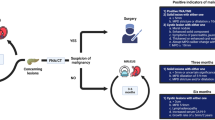Abstract
Background
Gallbladder polyps are relatively common. Although most gallbladder polyps are benign, some are malignant. Current guidelines state that malignancy should be suspected for polyps ≥ 10 mm in diameter. We clarified the cancer detection rates in accordance with the size distribution of gallbladder polyps, and evaluated the effectiveness of the reported risk factors in predicting malignancy.
Methods
In this retrospective case–control study, our institutional database was searched to identify patients who underwent laparoscopic cholecystectomy for benign or malignant gallbladder polyps at Sada Hospital, Japan. The chi-squared test was used to analyze the risk factors for malignancy.
Results
There were 227 protruding gallbladder lesions. The 206 benign polyps had a diameter of 2–21 mm, while the 21 malignant polyps were 7–60 mm. The cancer detection rates were 16.4% for lesions ≥ 10 mm, 55.9% for lesions ≥ 15 mm, and 94.1% for lesions ≥ 20 mm. Of the benign lesions, cholesterol polyps were the most frequent (50–100%) in all size ranges, even in large lesions (≥ 15 mm). The sessile lesion morphology was significantly more frequent in malignant (60%) than benign lesions (3.4%, p < 0.00001). Multiple polyps were frequently diagnosed not only as cholesterol polyps (81.1%), but also as adenomas (60%); adenomas were found as a single adenoma within other types of polyps. There were two cases of malignant small gallbladder polyps (< 10 mm); these lesions met the surgical indications of a size increase during observation or a sessile morphology.
Conclusions
The cancer detection rate increased significantly with an increase in the lesion size. Risk factors such as a sessile polyp morphology or an increase in lesion size were effective in predicting malignancy for small gallbladder polyps. It might be difficult to accurately predict the pathologic diagnoses of gallbladder polyps preoperatively, as cholesterol polyps were most frequent, even in the large size range.




Similar content being viewed by others
References
Wiles R, Thoeni RF, Barbu ST, Vashist YK, Rafaelsen SR, Dewhurst C, Arvanitakis M, Lahaye M, Soltes M, Perinel J, Roberts SA (2017) Management and follow-up of gallbladder polyps: joint guidelines between the European Society of Gastrointestinal and Abdominal Radiology (ESGAR), European Association for Endoscopic Surgery and other Interventional Techniques (EAES), International Societ. Eur Radiol 27:3856–3866
McCain RS, Diamond A, Jones C, Coleman HG (2018) Current practices and future prospects for the management of gallbladder polyps: a topical review. World J Gastroenterol 24:2844–2852
Dilek ON, Karasu S, Dilek FH (2019) Diagnosis and treatment of gallbladder polyps: current perspectives. Euroasian J Hepato-gastroenterol 9:40–48
Owen CC, Bilhartz LE (2003) Gallbladder polyps, cholesterolosis, adenomyomatosis, and acute acalculous cholecystitis. Semin Gastrointest Dis 14:178–188
Bhatt NR, Gillis A, Smoothey CO, Awan FN, Ridgway PF (2016) Evidence based management of polyps of the gall bladder: a systematic review of the risk factors of malignancy. Surgeon 14:278–286
Babu BI, Dennison AR, Garcea G (2015) Management and diagnosis of gallbladder polyps: a systematic review. Langenbeck’s Arch Surg 400:455–462
Krell RW, Wei AC (2019) Gallbladder cancer: surgical management. Chin Clin Oncol 8:36
Ito H, Hann LE, D’Angelica M, Allen P, Fong Y, Dematteo RP, Klimstra DS, Blumgart LH, Jarnagin WR (2009) Polypoid lesions of the gallbladder: diagnosis and followup. J Am Coll Surg 208:570–575
Sugiyama M, Xie XY, Atomi Y, Saito M (1999) Differential diagnosis of small polypoid lesions of the gallbladder: the value of endoscopic ultrasonography. Ann Surg 229:498–504
Tsuchiya Y, Uchimura M (1986) Collective review of 503 cases of small polypoid lesions (less than 20 mm in maximum diameter) of the gallbladder: size distribution in various diseases and that of the depth of carcinomatous invasion. J Jpn Soc Gastroenterol 83:2086–2087
Csendes A, Burgos AM, Csendes P, Smok G, Rojas J (2001) Late follow-up of polypoid lesions of the gallbladder smaller than 10 mm. Ann Surg 234:657–660
Veloso MGP, Rodrigues DN (2011) Gallbladder carcinoma: clinicopathological study of 24 cases. J Bras Patol e Med Lab 47:439–444
Golse N, Lewin M, Rode A, Sebagh M, Mabrut J-Y (2017) Gallbladder adenomyomatosis: diagnosis and management. J Visc Surg 154:345–353
Acknowledgements
We thank all the medical staff, nurses, and surgeons of Sada Hospital who contributed by performing the cholecystectomy surgeries and collecting the data. We also thank Kelly Zammit, BVSc, from Edanz Group (https://en-author-services.edanzgroup.com/ac) for editing a draft of this manuscript.
Funding
The authors received no specific funding for this work.
Author information
Authors and Affiliations
Corresponding author
Ethics declarations
Disclosures
Drs. Kenji Fujiwara, Atsushi Abe, Toshihiro Masatsugu, Tatsuya Hirano, and Masayuki Sada have no conflicts of interest or financial ties to disclose.
Ethical approval
Sada Hospital has its own Institutional Review Board (IRB) that reviews all studies performed in the hospital. The IRB approved the use of the database for research purposes and waived the requirement for informed consent (IRB approval number: S190726-1). All data were fully anonymized before being assessed.
Additional information
Publisher's Note
Springer Nature remains neutral with regard to jurisdictional claims in published maps and institutional affiliations.
Rights and permissions
About this article
Cite this article
Fujiwara, K., Abe, A., Masatsugu, T. et al. Effect of gallbladder polyp size on the prediction and detection of gallbladder cancer. Surg Endosc 35, 5179–5185 (2021). https://doi.org/10.1007/s00464-020-08010-8
Received:
Accepted:
Published:
Issue Date:
DOI: https://doi.org/10.1007/s00464-020-08010-8




